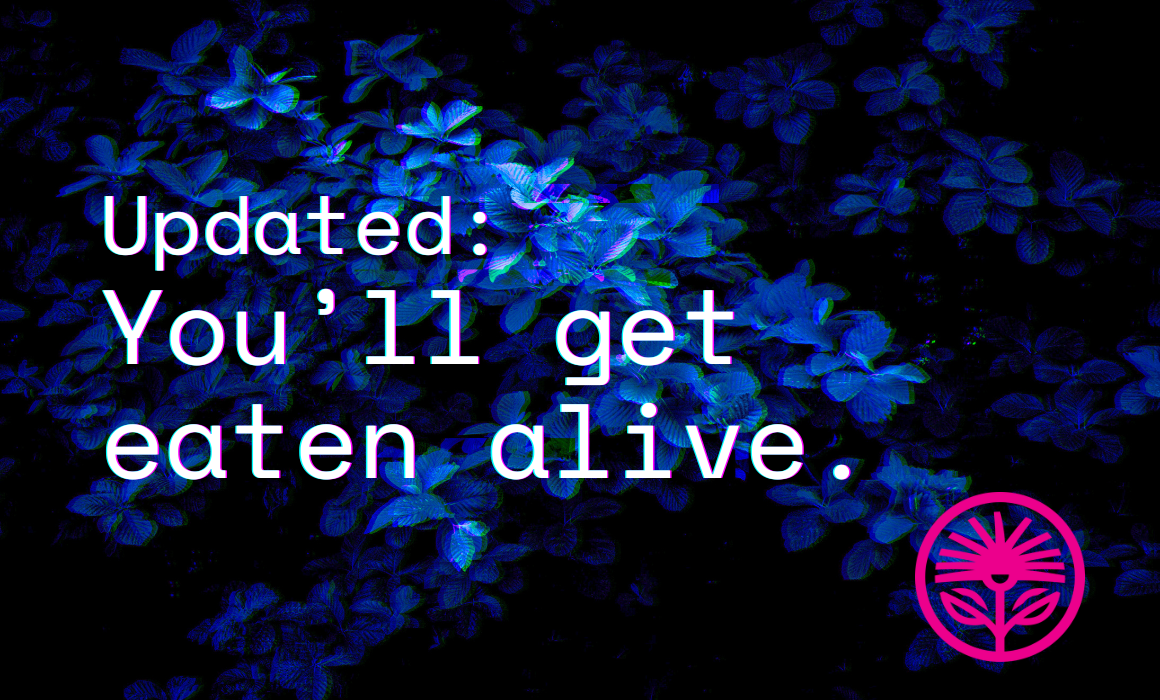Updated: You’ll get eaten alive — Kelford Labs Weekly
The answer to growth is focus.

This week’s newsletter is an updated post from August 2022. It’s easy to forget to whom we’re marketing—to whom we’re actually selling. This post is a reminder to focus on our customers, not our competition, and to do everything we can to become the most credible source of one thing in particular.

In 1916, the Saturday Evening Post published “Obvious Adams: The Story of a Successful Business Man” by Robert Updegraff.
In the story, the titular Adams becomes a sought-after consultant to business leaders who know they've been blinded by their own narrow perspective.
Adams sees through the fog and comes up with marketing solution after marketing solution that is simple, effective, and—once you hear it—completely obvious.
In one tale, Adams meets with the owner of a paper company, Mr. Merritt, and says that his advertisements should be clear statements of fact about how their paper is made.
Mr. Merritt, though, objects. While what Adams wants to promote about their process is true, it isn’t necessarily unique to Merritt’s business.
“We should be the laughingstock of all the paper-makers in the country,” Mr. Merritt says, “if they saw us come out and talk that way about our paper, when all of the good ones make their paper that way."
This is my favourite part:
“Adams bent forward and looked Mr. Merritt squarely in the eyes. ‘Mr. Merritt, to whom are you advertising—paper-makers or paper users?’”
Have you been there?
Have you ever directed your marketing at someone, or something, other than your ideal customers?
It’s okay, we all have.
Mr. Merritt was making the all-time classic mistake of seeing his marketing as a public broadcast, merely a “branding” exercise detached from the individual motives and needs of his actual customers.
He started to see his advertising as a way to communicate and signal to his competition and his peers, and not as a way of attracting his ideal customers.
Frankly, he saw his advertising as being about him and his business, and not about the people who used—or whom he wanted to use—his products.
Claude C. Hopkins, a contemporary of the fictionalized Adams, wrote in his 1926 autobiography that marketers too often “try to broadcast our seed in the hope that some part will take root.”
Instead, he says, “We must get down to individuals. We must treat people in advertising as we treat them in person. Center on their desires. Consider the person who stands before you.”
“However big your business,” Hopkins wrote, “get down to the units, for those units are all that make size.”
That’s why promoting products, places, or services meant for “everyone” is so difficult. No one sees themselves as generic—we all think we’re special. If it’s good for everyone, we think, it’s not ideal for me.
In traditional businesses, forgetting about the individual customer usually leads to broadly targeted and completely pointless sentiment-based branding ads. They inspire us to consider what a banal adjective might mean in the context of our modern, hectic lives, and they show us how noticing the morning dew on a blade of grass might make us consider buying a mid-range sedan or taking a vacation.
In startups, it leads to dumping cash into aggressive search advertising, “demand generation”, and roving hordes of desperate, headset-clad sales reps.
But all of these tactics assume that a business can force the issue, that if they get enough views, pound enough pavement, film enough slow-mo b-roll, make enough cold calls, post enough memes, or spend enough money on ads no one will ever see, that the customers or the visitors will come.
If we look popular and important, they seem to be thinking, we'll become popular and important.
Or, as Jack Trout and Al Ries wrote in The 22 Immutable Laws of Marketing, "There seems to be an almost religious belief that the wider net catches more customers, in spite of many examples to the contrary.”
As Jonathan Stark is fond of saying on Ditching Hourly: You’re not casting a wider net, you’re making a bigger ocean.
This is the mistake that the folks at Pebble made as the Apple Watch was entering their space. As the founder of the now-defunct company wrote, “In 2015, we had the option to narrow our focus to a smaller but more distinct market positioning. Looking back, this is one of my biggest regrets. We could have been the smartwatch for hackers but we tried to grow our volumes and market share (and failed).” [Emphasis mine]
They stopped thinking about their best customers, and they started thinking about themselves. Their growth, their future. Their importance.
They thought they could grow into relevance, and became less so. They tried to expand into profit, and lost it all.
The answer to more was less.
The answer to growth was focus.
Josh Kaufman, in The Personal MBA, puts it this way: “Attempting to appeal to everyone is a waste of time and money: focus your marketing efforts on your Probable Purchaser. By spending your limited resources reaching out to people who are already interested in the types of things you offer, you'll maximize the effectiveness of your attention-grabbing activities.”
Or as Vajre and Spett warn in ABM is B2B, "If you're a B2B marketer, and you don't know who you're selling to, what are you doing?”
“If the answer is anything except strategizing, you'll get eaten alive.”
But, I get it, focusing sucks. Targeting a core audience group feels risky.
It feels like you’re leaving money on the table. It feels like you’re reducing the scope of your ambition.
But you’re not—the money was never in mass appeal, it was in focused appeal. It wasn’t in becoming a big name, it was in becoming the only name. Or to paraphrase Blair Enns, it’s okay to pigeonhole yourself. Because those pigeonholes are stuffed with cash.
We’ve got to face it, one way or another your business—your destination, your organization, your startup—is going to end up being known for something. And you get to pick what.
Will it be known for its relentless and costly expansion into irrelevance?
Or for becoming better and better at the one thing its ideal customers value most?
Every day, we decide which way we’re heading. And every decision we make is placing a bet on one of those options.
As decision scientist and poker champ Annie Duke says, “Whether you acknowledge it or not, making a decision is making a guess about how things might turn out. If you’re shooting arrows, they are going to hit something."
Your business is going to end up somewhere.
“Better,” Duke says, “to take off the blindfold and aim with your eyes wide open.”
We need to open our eyes and direct them at our very best customers—our “probable purchasers.”
We need to pay attention and speak directly to the people who value what we do more than any other option—because we’ve focused our business on their needs above all others.
And we need to focus our marketing on the one thing that makes us uniquely suited for those customers—the one thing nobody can do as well as we can.
And the best part is, focusing makes you more appealing to a wider audience than expansion ever could. Because when you're a credible expert in one area, for good or bad, people just assume you've got expertise in other areas, too.
But when you do everything, people just assume you don’t do any of it very well.
“The target is not the market,” as Ries and Trout wrote. “That is, the apparent target of your marketing is not the same as the people who will actually buy your product.” Even if your target is young people, “the 50-year-old guy who wants to think he's 29 will drink the Pepsi.”
So, I get it. Your product was made for one type of customer in particular, but it’s so great that everyone should use it.
Or maybe your business, your destination, or your community has so much to offer that you want to talk about it all in every ad.
But, don’t.
“The target is not the market,” Blair Enns reiterates in the Win Without Pitching Manifesto.
“We take precise aim at the smaller target and are happy to hit the wider market. Our claim of expertise should be a lot narrower than the sum of our capabilities.”
The narrower your claims, the more credible they become.
Your claims of expertise are subject to what Gerald Weinberg called The Law of Strawberry Jam: “The wider you spread it, the thinner it gets.”
If you can get known for one thing, you stand a shot at becoming known for other things. But if you try to get known for many things, nobody’s going to notice you at all.
So, to grow, we’ve got to focus.
To expand, we’ve got to focus.
To be sustainable for the long-term—well, we’ve got to focus.
And what do we focus on? What Hopkins said: The people who stand before us.
The individuals who buy what we sell because they prefer it over everything else.
When we focus on everyone, or doing everything, we end up finding fewer and fewer people, buying less and less.
But when we focus on just our best customers, and just what we do best, we find that every time we look, there’s more.
Kelford Inc. helps hands-on entrepreneurs and founders with complex marketing challenges define and articulate their unique value to their very best customers.
We’ll show you the way to always knowing what to say.



